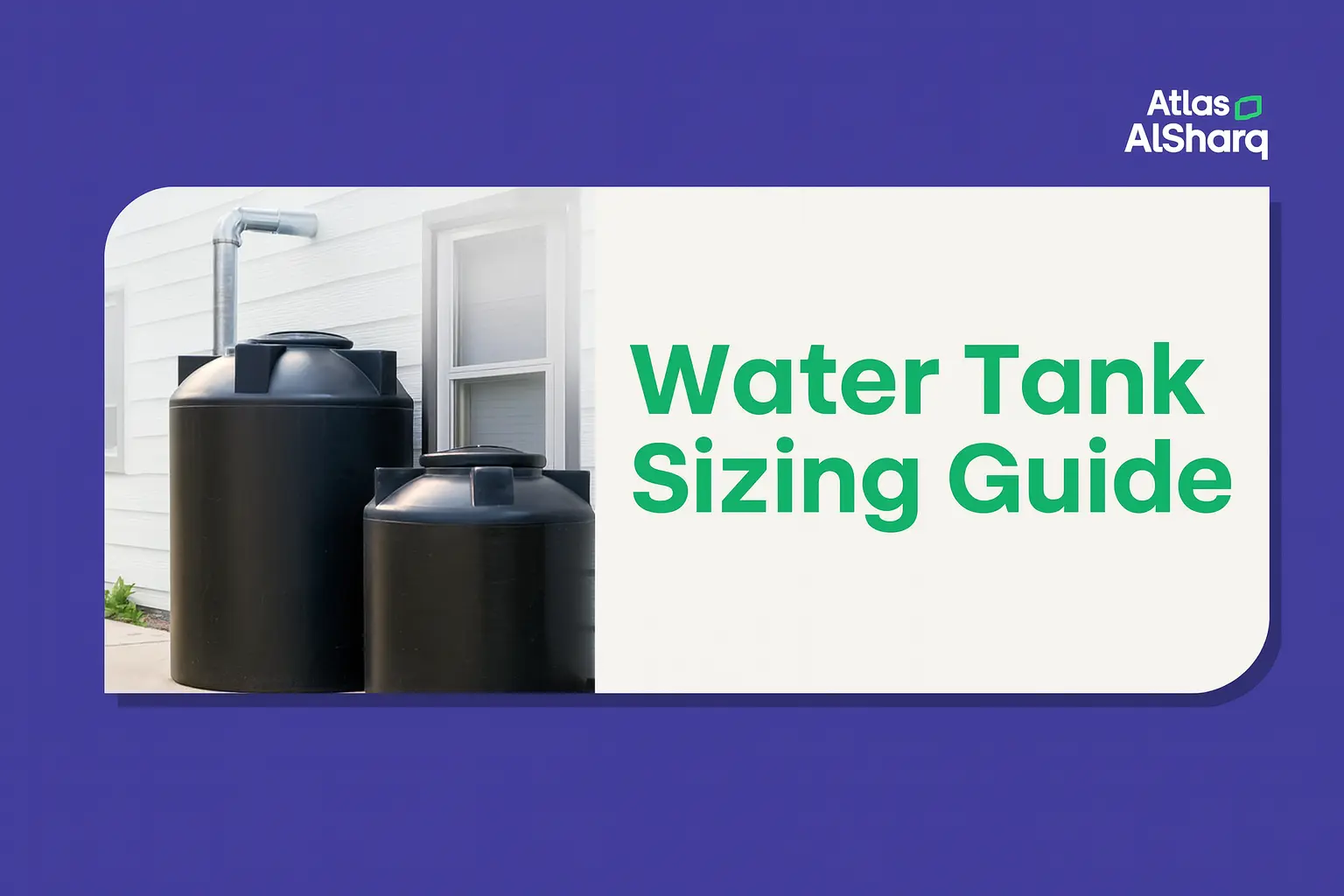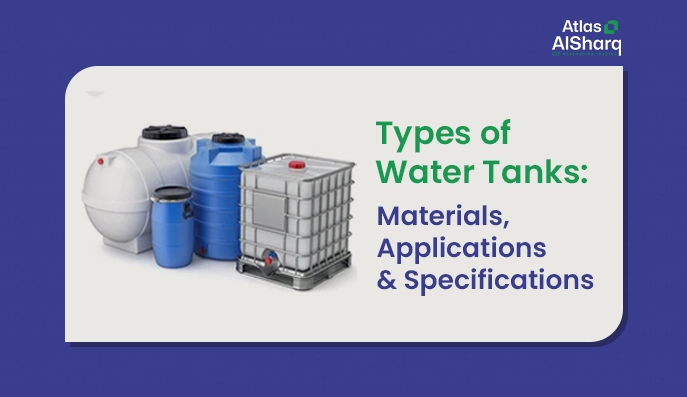Water Tank Sizing Guide: How to Choose the Right Capacity for Your Home or Building
October 21, 2025
|Water Tank

Table of Contents
- Why Water Tank Size Matters
- Understanding Water Consumption Basics
- How to Size a Water Tank
- Water Tank Size Chart: Quick Reference
- Choosing the Right Tank Material
- Atlas Al Sharq offers a complete range of water storage solutions to meet diverse requirements.
- Additional Considerations When Sizing
- Common Mistakes to Avoid
- Professional Water Storage Solutions from Atlas Al Sharq
- Get your perfect water tank solution
- Conclusion
Imagine this: It’s a hot summer day in Dubai, and you’re anticipating a cool shower after a long day—only to have your water tank gone dry. Or maybe you’ve recently bought an oversized tank that’s wasting you money while gobbling up precious storage space. These are more frequent than you might imagine, and all of them have one major thing in common: incorrect water tank sizing.
Selecting the optimal water tank capacity is not simply the selection of a number—it’s about guaranteeing efficiency, cost-effectiveness, and a constant water supply for your business or home. If you’re getting a new tank installed, replacing an existing tank, or are about to start a building project, knowing how to correctly size your water tank is critical. In this in-depth guide, you will discover precisely how to determine the ideal tank capacity for your individual requirements, without either shortages or over-expenditure.
Why Water Tank Size Matters
It is important to get your tank size correct for a number of reasons. If you undersize a tank, you’re forced to experience repeated water shortages, particularly during times of peak demand. This subjects your pump system to unnecessary stress, resulting in premature wear and unnecessary maintenance expenses. You’ll also be excessively reliant on municipal water supply, which can prove inconvenient with service disruptions.
Conversely, tank oversizing also has its drawbacks. You’ll pay more initially for a larger tank than you really need to, waste precious installation space, and maybe even experience water stagnation problems if the stored water isn’t used up regularly. Stagnant water can foster bacterial growth and degrade water quality in the long term—issues that make regular professional water tank cleaning essential for maintaining safe drinking water.
The objective of accurate water tank capacity calculation is to achieve that golden mean—a tank capacity that optimizes your actual consumption requirements and suitable backup storage, providing a guarantee of supplies without excess waste.
Understanding Water Consumption Basics
Average Daily Water Usage Per Person
Before you decide on a tank size, you must know average water usage habits. The average figure is 150–200 liters per person per day, although water consumption varies dramatically by region and lifestyle. This daily consumption is divided between different activities: washing and drinking (10-15 liters), showering and bathing and toilet hygiene (50-80 liters), washing clothes (30-40 liters), flushing toilets (30-40 liters), and cleaning generally (20-30 liters).
Factors That Affect Consumption
Your family size is only the beginning. Think about your habits—do you have a lot of visitors? Do you have pets? Those all add to the everyday consumption. If you have a garden, a swimming pool, or wash cars on a regular basis, you’ll need to factor in substantial extra water use above the per-person minimum.
Commercial enterprises have very different consumption patterns. Offices, hotels, schools, and hospitals all have particular usage rates depending on their usage and usage densities.
These considerations affect how you determine water tank capacity in liters for your case.
How to Size a Water Tank
The Basic Formula
The fundamental formula for sizing water tank capacity is straightforward:
Tank Capacity = Daily Water Consumption × Number of Days Storage Needed
Let’s walk through a practical example. Consider a family of four:
- 4 people × 150 liters per person = 600 liters per day
- For 2 days of storage: 600 × 2 = 1,200 liters minimum capacity
This calculation gives you the baseline, but you should always add a 20-30% safety buffer for unexpected needs or guests.
Read More: For more complex tank dimension calculations or to determine tank capacity based on specific measurements, you can use this water tank capacity calculator.
Domestic Water Tank Sizing
- Small households (1–2 individuals): 500–1,000 liters should be plenty, allowing pleasant backup storage for brief supply disruptions.
- Medium households (3–5 individuals): You will require 1,000–2,500 liters, with the precise volume depending on your lifestyle and whether you have outdoor water requirements.
- Large households (6+ individuals): Budget for 2,500–5,000 liters or more. Multi-generation homes or homes with large gardens might need considerably larger capacities.
Don’t forget to provide for that 20-30% emergency, visitor, and seasonal fluctuations in use buffer.
Commercial Water Tank Sizing
Commercial spaces have different computations depending on the usage type:
- Offices: 30–40 liters per person per day
- Hotels and restaurants: 100–150 liters per guest per day
- Schools: 20–30 liters per student per day
- Hospitals: 300–400 liters per bed per day
For instance, a small office building with 50 staff members would require around 2,000 liters per day (50 × 40 liters) and thus need a 4,000-5,000 liter tank for two days of stand-by storage.
Regional Adjustments for UAE
In Dubai and UAE, there are certain considerations. The harsh summer conditions cause a 15-25% increase in water usage over cooler months. Irrigation requirements for grounds keeping are always necessary year-round, and most buildings have to meet Dubai Municipality regulations for minimum storage. GRP tank sizing in these areas typically incorporates these regional considerations from the beginning.
Water Tank Size Chart: Quick Reference
Here’s a helpful guide for residential sizing based on 2-day storage:
- 1–2 people: 500–1,000 liters
- 3–4 people: 1,000–2,000 liters
- 5–6 people: 2,000–3,000 liters
- 7+ people: 3,000–5,000+ liters
Adjust these figures based on your specific storage duration needs and regional factors.
Choosing the Right Tank Material
After you’ve determined your needed capacity, finding the right tank material is important for long-term reliability and performance.
- Polyethylene Tanks – Ideal for residential use, these lightweight, corrosion-resistant tanks are easy to install and perfect for rooftop setups.
- GRP (Glass Reinforced Plastic) Tanks – Best suited for the UAE’s harsh climate, GRP tanks offer exceptional strength, hygiene, and chemical resistance. Their modular design allows easy capacity expansion, making them ideal for commercial and industrial use.When properly installed with professional GRP lining and waterproofing, these tanks provide decades of reliable service.
- Fiberglass & Steel Tanks – Steel provides durability for large-scale installations, while fiberglass offers excellent chemical resistance—each suited to specific needs, costs, and site conditions. For comprehensive leak prevention, consider expert GRP pipe joint lamination to ensure your entire water storage system remains watertight.
Atlas Al Sharq offers a complete range of water storage solutions to meet diverse requirements.
Let’s Build Something Great Together
Additional Considerations When Sizing
- Storage Duration – For reliable daily water supply, 1–2 days’ storage is sufficient. In areas with intermittent supply, plan for 3–5 days or more, and always account for emergency backup in critical facilities like hospitals and industrial sites.
- Space and Installation Constraints – Overhead tanks must consider roof load capacity, while buried tanks need adequate excavation space. Both footprint and height limitations can restrict tank size regardless of your calculated requirements.
- Maintenance and Water Quality – Oversized tanks can cause water stagnation.Regular professional cleaning and maintenance are essential to keep stored water safe and compliant with health standards.
Common Mistakes to Avoid
Don’t make these frequent errors when sizing your water tank:
- Ignoring future growth: Your family might expand, or your business may grow
- Gross outdoor use: Washing vehicles and gardening can double your water usage
- Omitting the safety margin: Always include 20-30% additional capacity
- Cost-only selection: Selecting a tank only because it’s cheap and not by real need and quality
- Omitting supply reliability: Failing to factor in your location’s water pressure and supply stability
- Omitting compliance requirements: Not including Dubai Municipality or UAE Civil Defense regulations
Professional Water Storage Solutions from Atlas Al Sharq
At Atlas Al Sharq, proper tank sizing is just the beginning. As a leading UAE provider of water storage solutions, we offer end-to-end services—from consultation to installation and maintenance.
Our range includes polyethylene, GRP, fiberglass, and steel tanks, all meeting the highest industry standards. With years of experience serving residential, commercial, and industrial clients across Dubai, Abu Dhabi, Sharjah, and beyond, we deliver customized solutions for secure and eco-friendly water management.
Get your perfect water tank solution
Call Atlas Al Sharq now for professional guidance.
Related Service: We also specialize in GRP lining and waterproofing, professional tank cleaning to maintain water purity, and GRP pipe joint lamination for leak-free systems.
Conclusion
Accurate water tank sizing is a matter of basic mathematics: measure your daily usage, multiply it by how long you want to store water for, and factor in a buffer. Whether you require an undersized 1,000-liter poly tank for a small flat or an industrial-sized GRP system for an industrial building, knowing these fundamentals helps you make an educated choice.
For large-scale projects or if calculations are unclear, getting advice from experienced suppliers does make a lot of difference. At Atlas Al Sharq, our experts can evaluate your particular site conditions, take into account local compliance issues, and advise on the best tank configuration to suit your requirements.
Ready to discover the ideal water storage solution? Contact Atlas Al Sharq today for professional advice and an expert quote. Getting your water tank capacity just right in the first instance guarantees years of hassle-free water supply, cost-effectiveness, and peace of mind.
Frequently Asked Questions?
How do I calculate the right water tank size for my home?
Multiply your daily water usage (150-200 liters per person) by the number of people, then multiply by desired storage days (typically 2 days), and add a 20-30% safety buffer.
What size water tank do I need for a family of 4?
A family of four typically needs 1,200-1,600 liters for 2 days of storage, so a 1,500-2,000 liter tank is recommended.
How long should a water tank last without refilling?
For residential use, aim for 1-2 days of storage. In areas with unreliable supply, plan for 3-5 days or more.
What happens if my water tank is too big?
Oversized tanks lead to water stagnation, bacterial growth, higher initial costs, and wasted installation space.
hich tank material is best for UAE climate?
GRP (Glass Reinforced Plastic) tanks are ideal for UAE’s harsh climate due to their strength, heat resistance, and durability.
Explore Our Range and Enquire Now for Expert Advice!
Create Smart Solutions With Us Today

